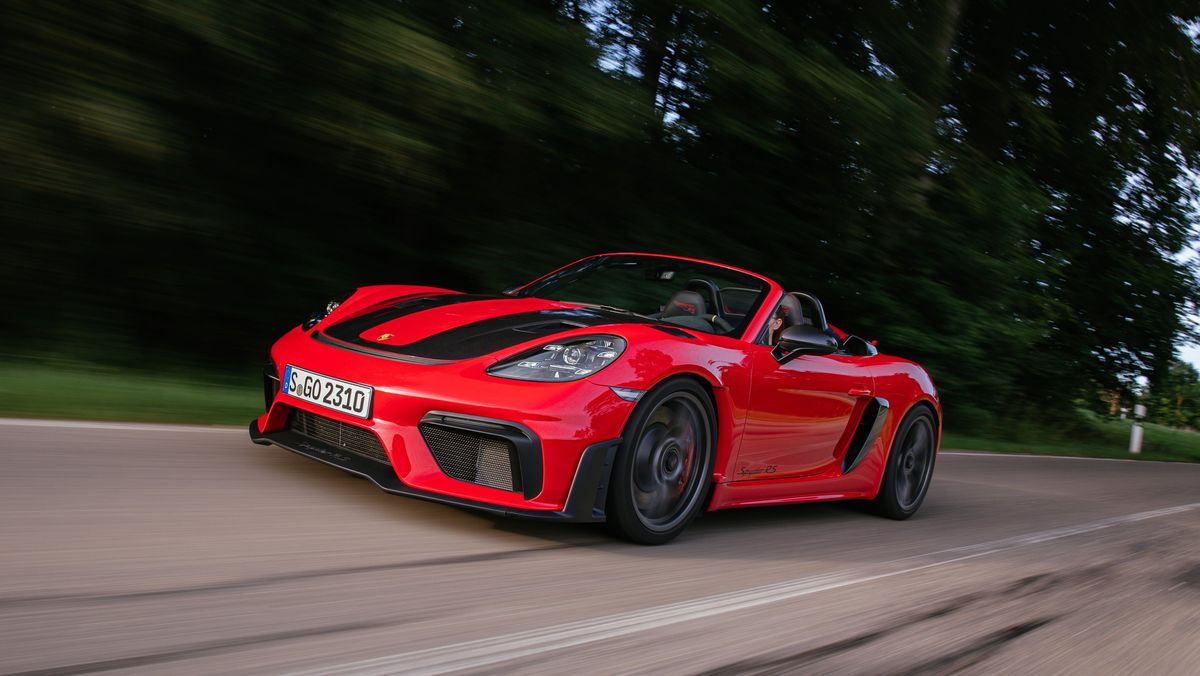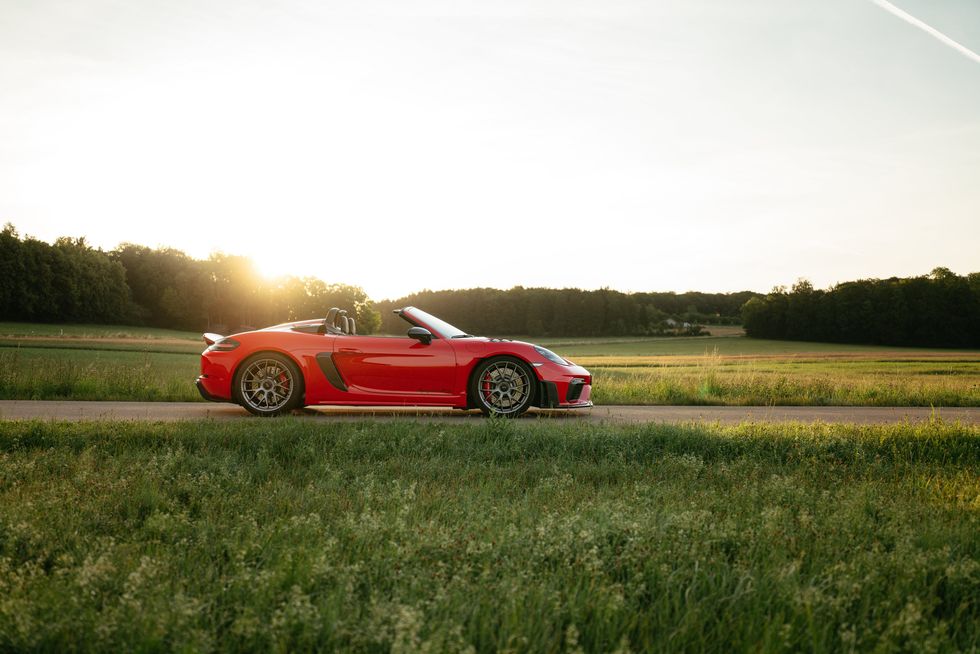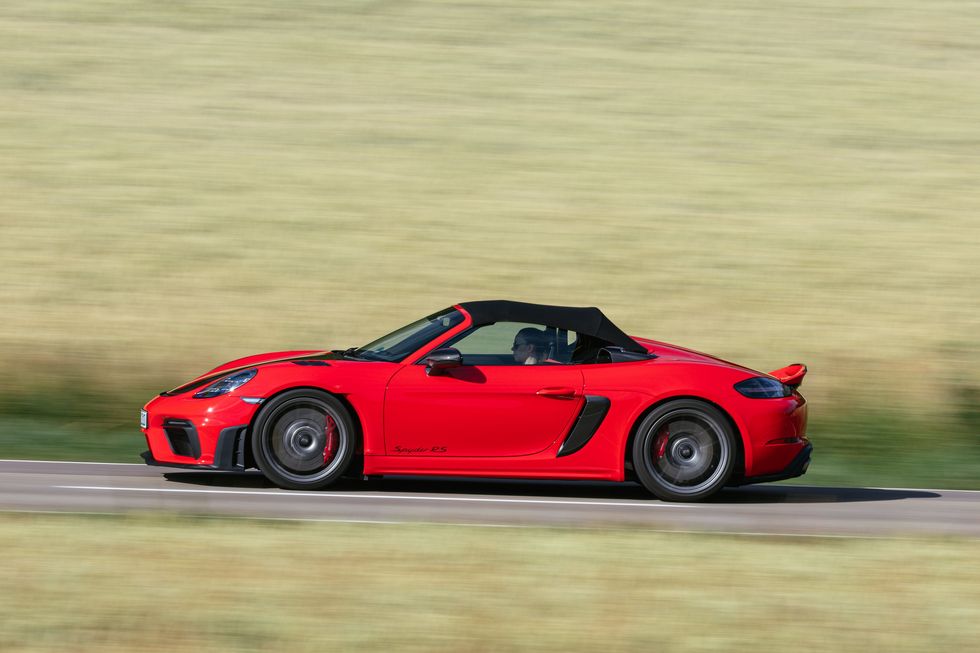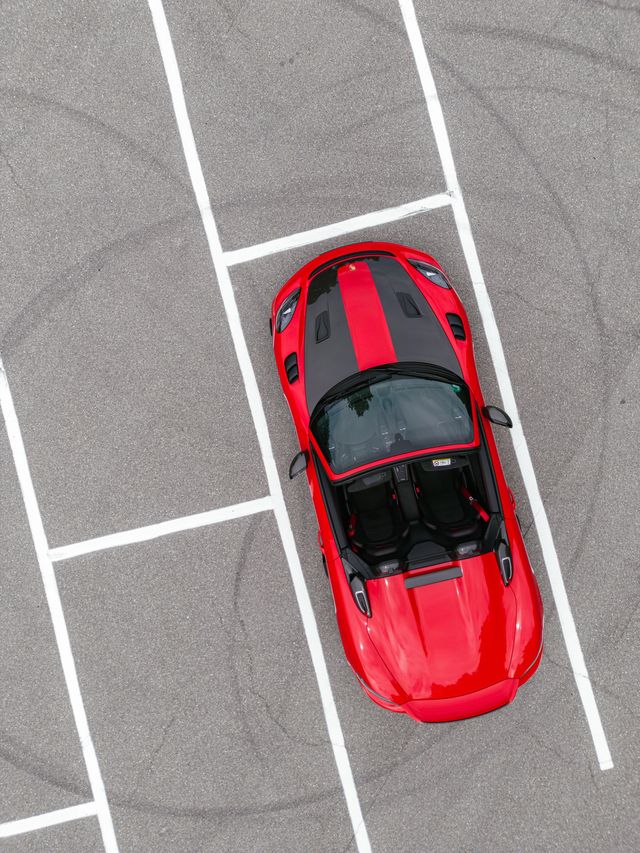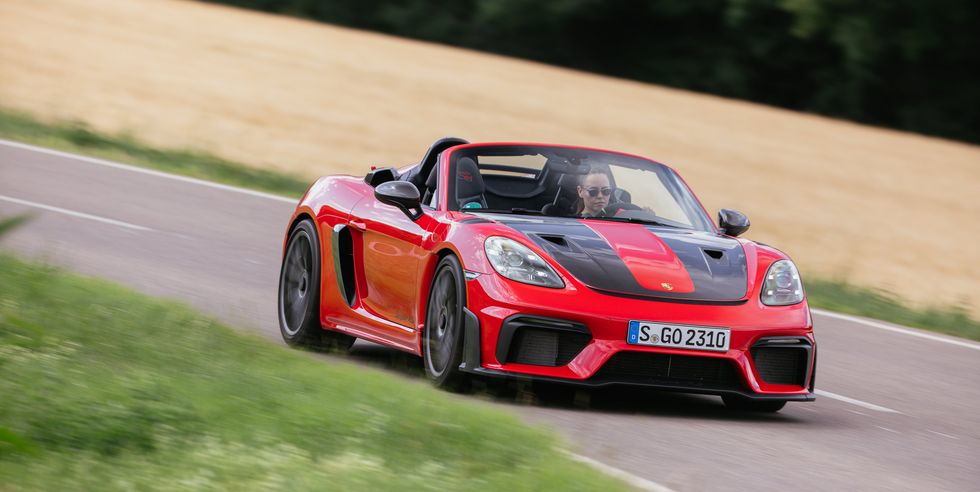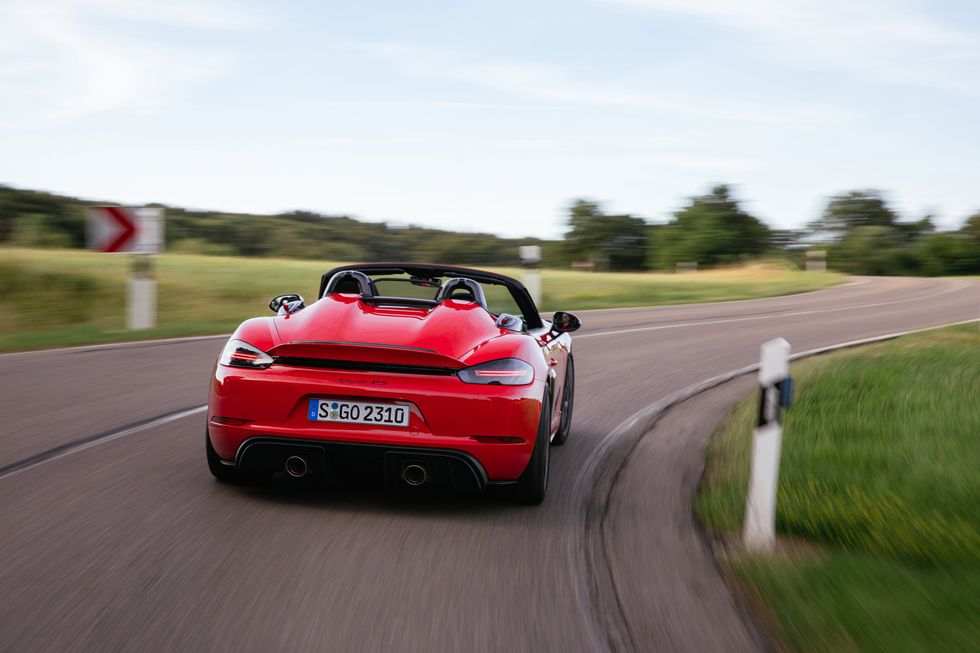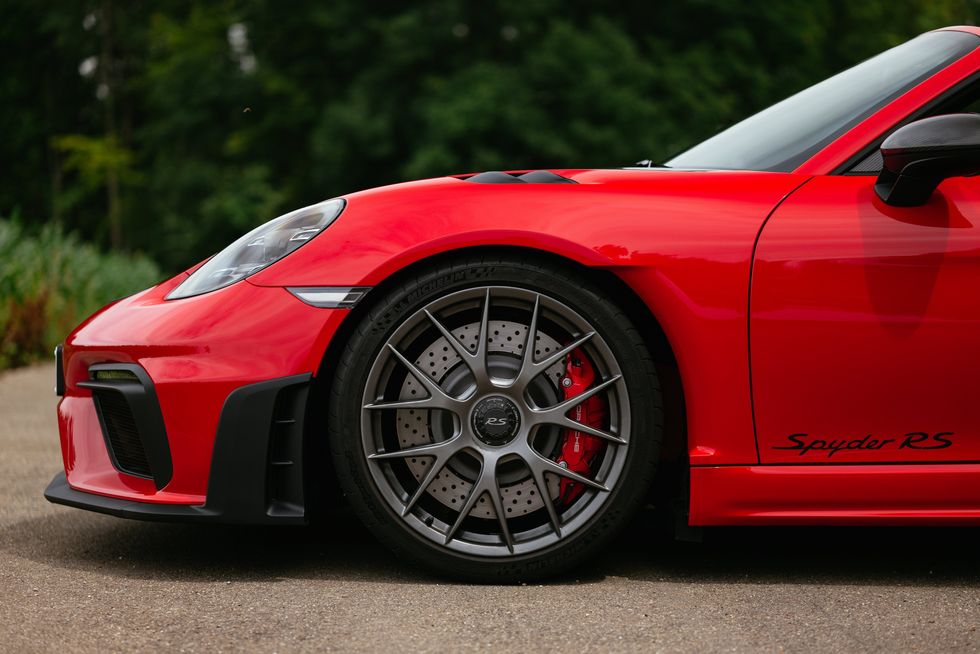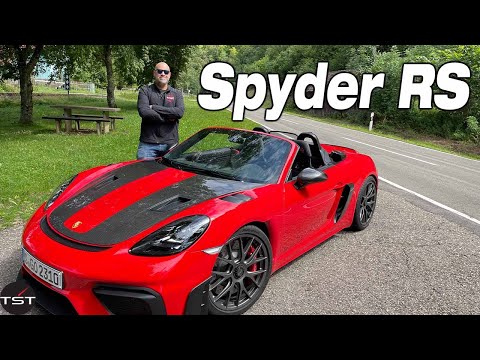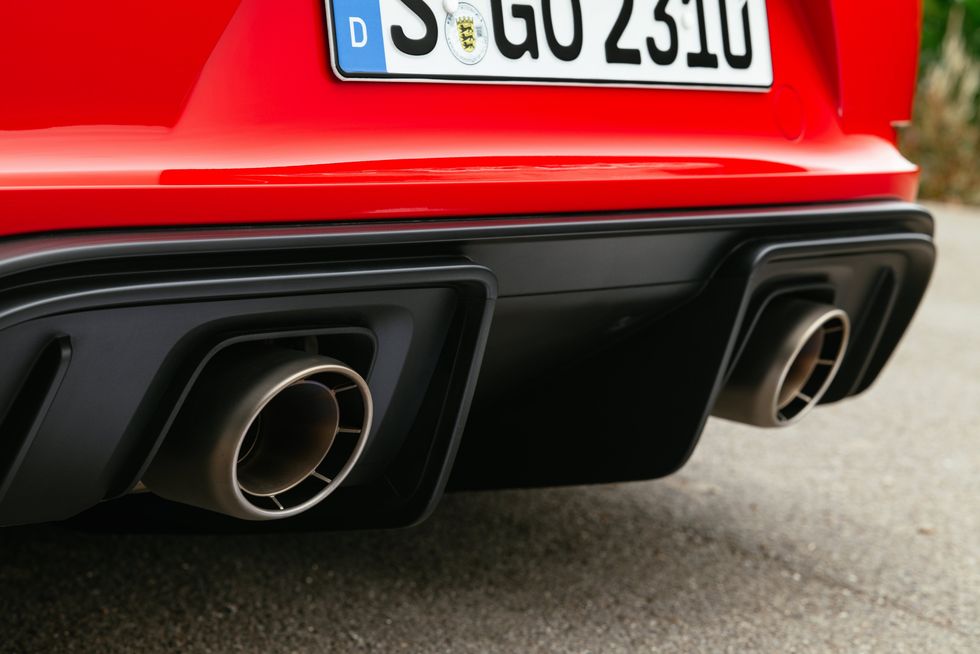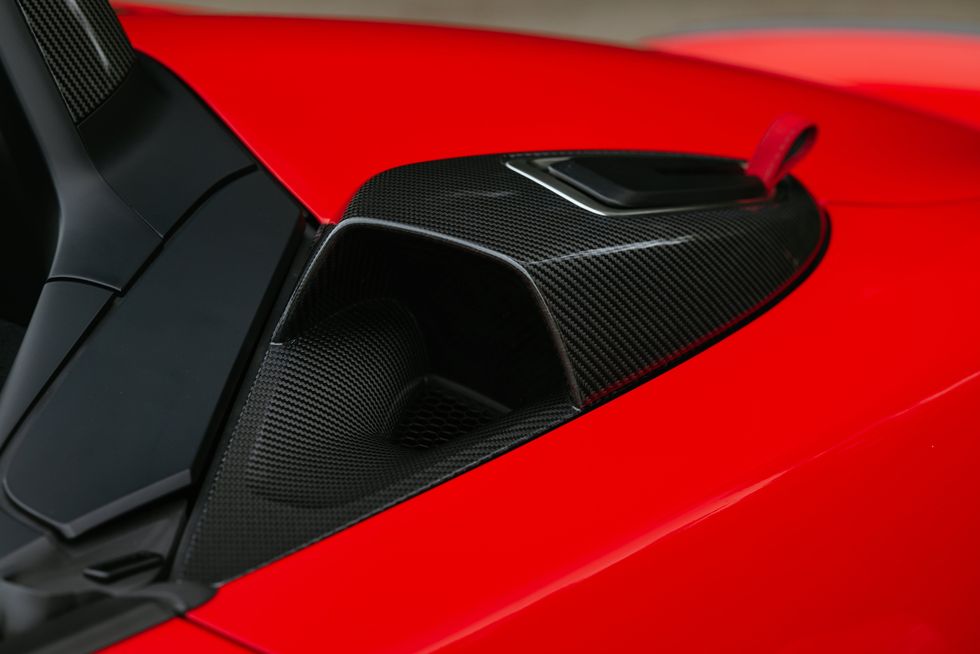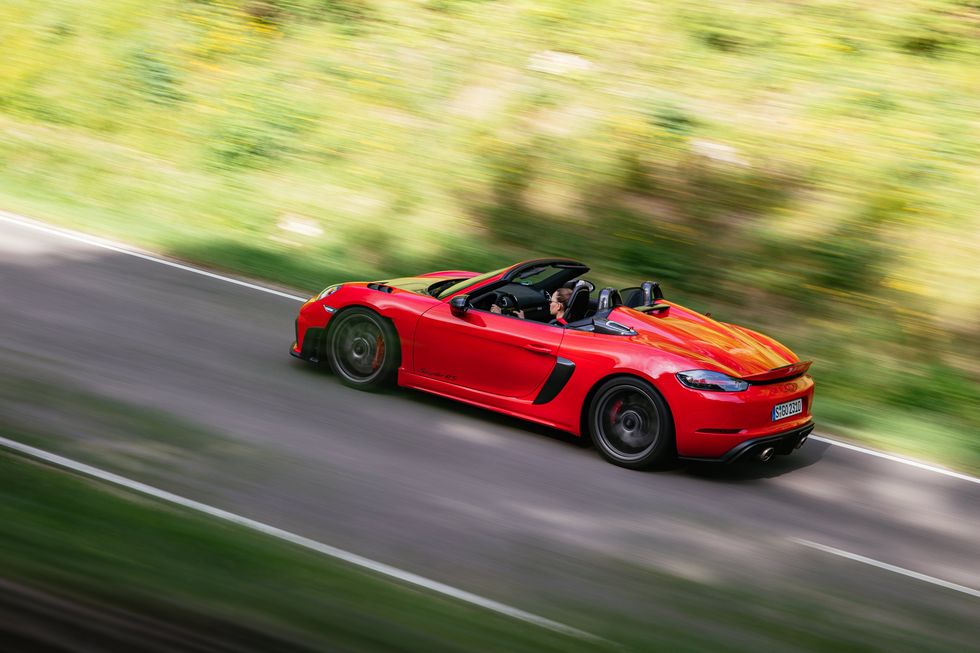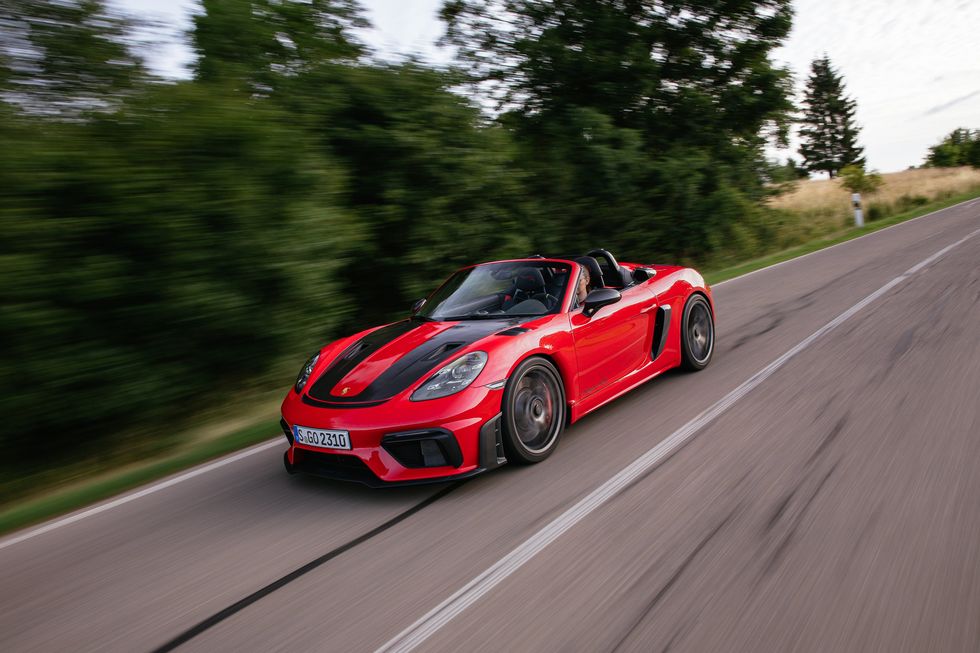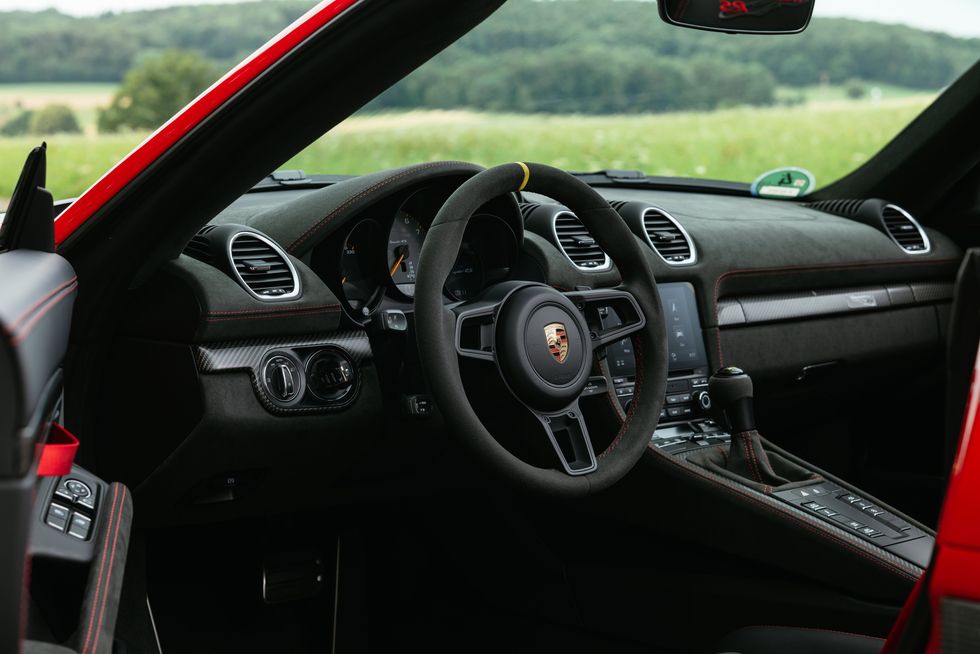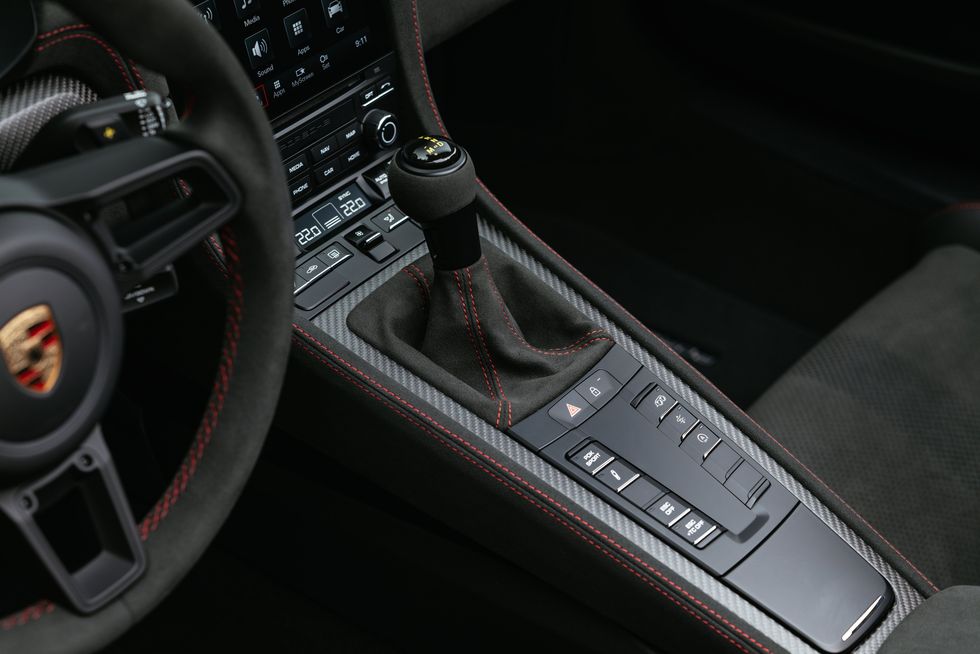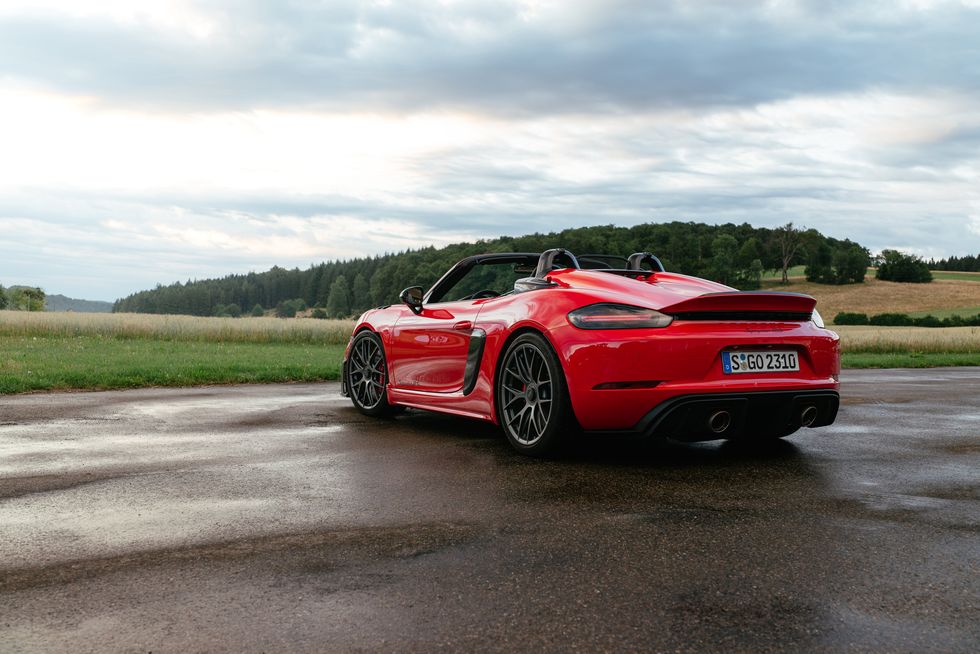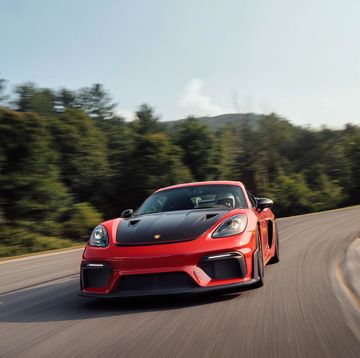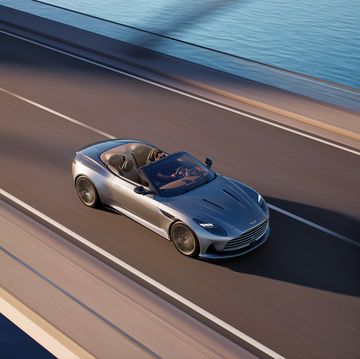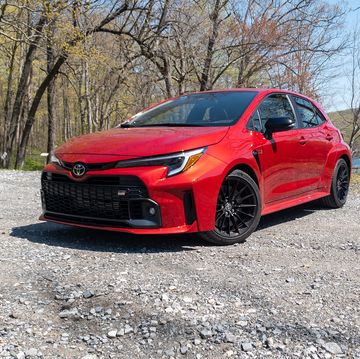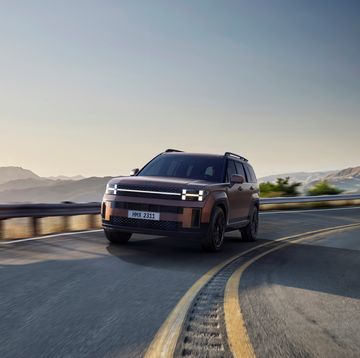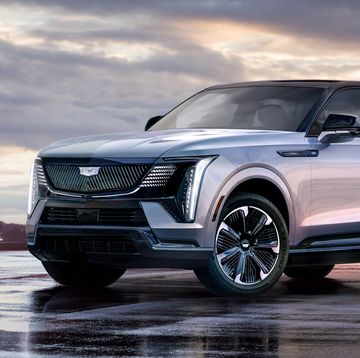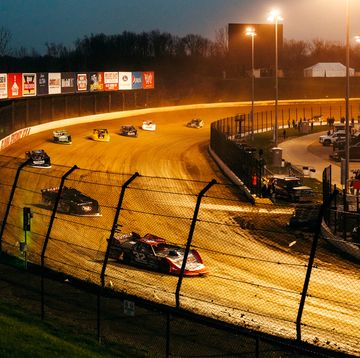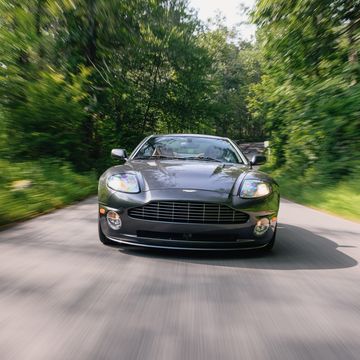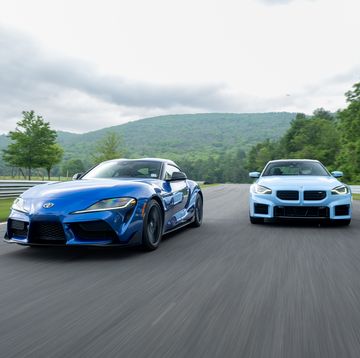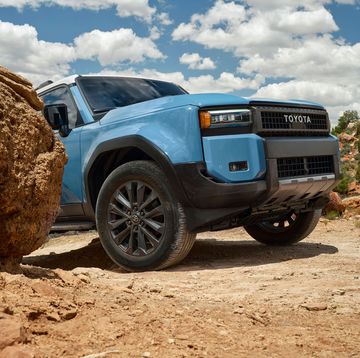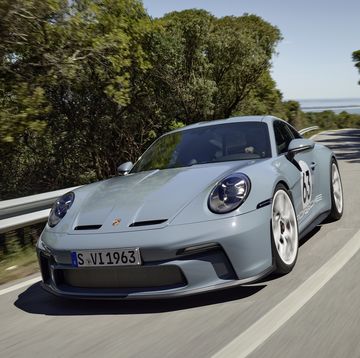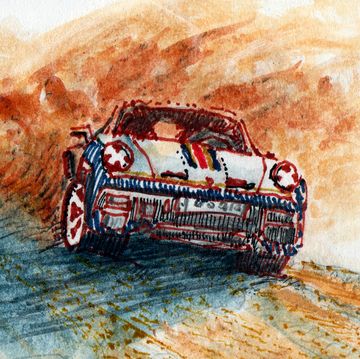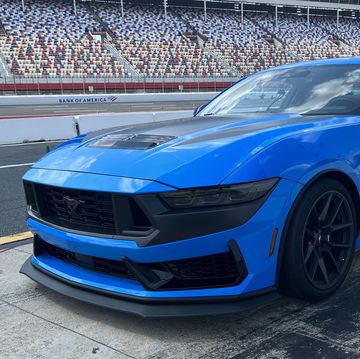Here’s the deal: Porsche says this is the last new internal-combustion Boxster. If that stirs inside you some unforeseen cocktail of nostalgia and sorrow, well, you’re not alone.
I’ve never owned a Boxster, nor have I ever shopped for one. But its introduction stirs up Nineties nostalgia, a sense of time and place, memories of how things were. In conjunction with the 996-generation 911, that first Boxster was bedrock, pivoting Porsche to its current position as purveyors of the most-desirable sports cars on earth.
Andy Preuninger spurred much of that success too. His stewardship of Porsche’s “GT” sub-brand, which began with the 996.2 GT3, helped shape our perception of the company in the 21st century. The GT cars’ hardcore tenor lent performance cred across Stuttgart’s range of lesser cars and indeed its SUVs.
So when Preuninger speaks about the newest car, which is also the internal-combustion Boxster's swan song, the room goes quiet.
“We wanted to do something completely different,” Preuninger says. “Combine GT genes with the speedster; a perfect alignment of two things that are fun as hell.”
Beside him sits that idea manifest, the 2024 Porsche 718 Boxter Spyder RS. It's essentially a GT4 RS with its roof lopped off, aimed exclusively at road duty. Gone is the big dorky wing affixed to the GT4 RS’s tail, and with it a sense of that track-nerd tryhard that’s either enticing or off-putting, depending on whether you’re the type of person who cites their HPDE lap times at family reunions.
Shorn of a roof and a wing, the Spyder RS is a great-looking car. Maybe even a beautiful one. While it effectively keeps the GT4 RS’s entire front clip, there’s something more essential, compact, and resolved about this Spyder’s looks.
Its roof is a thimble of fabric strung across the cabin that folds down then tucks neatly below a large clamshell at the car’s rear. That featherweight clamshell swoops along to car’s tail where a Gurney flap raises neatly at the Spyder RS’s trailing edge.
Though it stows away from sight, the folding soft top is no footnote. It’s a finicky thing to either stow or release, requiring the driver to roll (or unroll) the top like a camping tent before a procession of anchors and clips can be actuated. It takes a practiced hand a couple minutes to change the top, less if you have a passenger who’s familiar with the dance, but the process never feels trivial.
R&T editor-at-large Matt Farah, who owns a standard, albeit extensively modified, Boxster Spyder, felt particularly aggrieved by the top. His Spyder’s soft roof can be stowed much quicker than the RS’s, he says, though you still have to exit the driver’s seat to complete the dance with either car.
On the other hand, I’m the type of enthusiast who’s in for a penny, in for a pound. Like Porsche, I can explain away the finicky top because it saves a great deal of weight at the cost of convenience—the Spyder RS weighs 88 pounds less than a standard Spyder.
Somehow, it’s even 11 pounds lighter than the GT4 RS, with a final curb weight just over 3200 pounds. Much of that weight savings comes from this top, which weighs about 18 pounds total, but is strong enough to stay affixed WELL beyond whatever speed limit Porsche suggests to its customers, according to mischievous sources in the know.
I imagine that for every Spyder RS owner who doesn’t live in Southern California and drives their car regularly, there will be a couple times per year when a downpour catches you out. Decide if you’re a person who celebrates the occasional pair of wet undies with laughter, or the kind who cannot suffer water damage to their bespoke horsebit loafers. Spec your drop-top Porsche accordingly.
With the divisive top stowed, the car looks oddly understated. Even this Weissach-package Spyder RS (which adds $15,640 on top of the car’s $160,700 base price), with its Guards Red paint pared away to reveal racy carbon stripes, seems a world apart from the rest of the current RS lineup.
That’s intentional. While most of the RS cars under Preuninger have varied in their mixture of backroad joy and dead-serious track credentials, they’ve leaned hard toward the latter with time, chasing ‘Ring records at the expense of on-road civility. The current GT3 and GT4 RS are shining examples.
Therefore the Spyder RS is an inversion, a simpler recipe, Preuninger says; Chop off the roof; Chase maximum lightness, power, and speed; build a car for every sliver of writhing asphalt except the race track.
As such, the Spyder RS's spring and damper rates were selected for country roads, not struggling under the weight of mega-downforce on the front straight of some fabled racing temple, Preuninger says. So the Spyder RS rides 5 mm higher than its sibling, and uses roughly half the spring rate up front, and three-quarters at the rear to further compliance.
To offset that leniency, Porsche mitigates extra yaw and roll with its trick dampers.
Some more meaningful distinctions: The GT4 RS and Spyder RS use similar intake induction systems, which sit atop engine, but there’s a unique stainless exhaust system for the Spyder RS, paired to a unique underbody and a shorter splitter. But in every other way, the Spyder RS delivers on Preuninger’s promise of a headless GT4 RS, down to the exact tire size and compound shared between the cars.
Those are the Spyder RS’s bones and its corresponding promise to prospective owners, Preuninger says: This will be the most pure and emotional Boxster derivative ever.
Even from the passenger seat, the Spyder RS nails that promise. By some strange confluence of nuances, induction and exhaust notes are best savored without a steering wheel in your lap, that air inlet over your right shoulder seems to saw your head in half with the sound of ripping, whooshing suction. Especially when the 4.0-liter naturally aspirated flat-six is wound up against its 9000-rpm redline. Here it makes 493 horses at 8400 rpm and 331 lb-ft at 6250 rpm, and comes paired with an excellent seven-speed dual-clutch gearbox. (The Porsche GT department's six-speed manual doesn't fit behind this flat-six.)
This engine is capable of raising the level of engagement and enjoyment of any vehicle which it bestows its talents to. It’s an absolute high-water mark of a roadgoing internal-combustion engines, probably because it’s borrowed essentially unchanged from the 911 Cup car.
To my mind, the selling point of this vehicle has nothing to do with power figures or a lightweight top, but everything to do with when its power arrives and how it sounds while you’re getting there. By virtue of it's multitudinous and symphonic intake notes, the Spyder RS is perhaps the best-sounding thing on the road right now (though, perhaps, Lamborghini’s Huracan V-10, Ferrari’s N/A V-12, and the brooding thundercloud stuffed under the Cadillac CT5-V Blackwings’s hood share top honors).
Equipped to the Spyder RS, this engine doesn’t produce any of the harsh booming and resonance that the GT4 RS’s cabin produces. This car is all about chasing the sharp end of the tach on a hunt for that resonant intake honk that you feel humming in your chest, and the almighty sucking noise pulling acres of atmosphere over your shoulders, then waiting for the engine to belt out its full-throated howl at redline.
Plus the thing is a pleasure to actually drive.
In a set of downhill hairpins, past a stand of frowning construction workers at the edge of a narrow road set into Germany’s Swabian Alps, the hill goes falling, falling, falling…
The Spyder RS cribs the GT4 RS’s confidence, even when nosing deep into potholed hairpins. When you lean hard on the brakes and elbow the Spyder RS’s nose into a tight apex, the 245-width Michelins at the front refuse to wash. Instead, in those moments, you can still carry enough speed that on corner exit, traction control reins in wheel spin from that first stab at the throttle and stability control snatches at the moment of yaw.
I was worried that with a reduction in spring, plus an added smidge of ride height, there’d be too much tire to fit the Spyder RS’s road-going remit. But the tires work perfectly here, even under an overcast sky with patches of damp and greasy asphalt where canopies hide the rain-soaked morning from daybreak.
I prefer this drop-top RS to its thoroughbred brother. Both propose a degree of absurdity and impracticality that limit their flexibility, but in different ways. Despite the finicky roof, the use case for the Spyder RS is far broader, far more applicable and enjoyable than the GT4 RS. I could imagine taking this car to a relaxed track day; I can not imagine taking a GT4 RS out for a grocery run without noise-cancelling headphones.
Unlike the bracing and booming cabin of the GT4 RS, you don’t want to miss a second of this engine’s emotive personality in the Spyder RS, and ironically, it sounds even better with the thin bikini cover overhead. The fabric acts as a sort of speaker cone, focusing the good noises around your dome, but without overcoming the driver or passenger with sheer volume. In my notes, on the ground, I wrote:
“Holy shit! The top amplifies the throatier notes from the engine. Its low-down snorts and huffs resonate in your chest, adding further reverberation and resonance, reavealing added texture to the engine note at any rpm, slicing the intake noise into finer pieces.”
It’s ironic that the Spyder sounds best with the top on and the active exhaust disengaged (set to “quiet mode,” effectively), but there you have it.
The Spyder RS’s interior feels typical Porsche. I’ll never grow tired of heaping praise on the button-less, switch-less, bullshit-lees steering wheel sitting front and center for the driver. It’s simply a round thing (no flat bottom here) for aiming the car’s nose with two hands. Nothing more or less. Amen.
Typical Porsche restraint drapes the rest of the cabin, too. Even with the optional “Race-Tex” fabric-and-leather seats selected (another $2160 option), and "Weissach RS" stitched into the headrests, this interior does little else to elevate itself beyond the bones of the standard Boxster’s $70,000 price tag beyond fabric selection.
As much as I love its steering wheel and sensible switchgear and the look of this car from the outside, I’m often at odds with Porsche’s overall restraint inside the cabin. I feel the same about the Spider RS, which will surely crest $200,000 for most buyers but feels less flavorful than any BMW performance car (including the cut-rate-by-comparison M2) if you glance inside the cabin.
This will matter very little. Like all Porsche GT products, every single one of these cars will certainly be spoken for. Porsche wouldn't say how long it'll keep building the Spyder RS, but that its production won't be limited.
If this is really the final internal-combustion 718 Boxster, well, it’s a damned good blowout. In the near future, when the quiet thrum of an electric motor or the added weight of a hybrid system dulls the magic by comparison, I'll think back to this car's exhaust whomp doppelering off the sheer rock faces lining rural Germany's backroads, to the almighty sucking noise of those two intake inlets, to they joy of a 9000-rpm flat-six, and smile.
The only member of staff to flip a grain truck on its roof, Kyle Kinard is R&T's senior editor and resident malcontent. He lives near Seattle and enjoys the rain. His column, Kinardi Line, runs when it runs.
